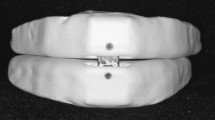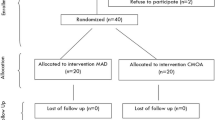Abstract
The objective of this study was to compare the effect of two different degrees of mandibular advancement (MA), 75% versus 50%, on somnographic variables after 6 months of dental appliance treatment in patients with severe obstructive sleep apnea (OSA). A further purpose was to compare the number of adverse events on the stomatognathic system and the effects of dental appliance treatment on the presence of daytime sleepiness.
Eighty-six males with severe OSA (apnea index ≥ 20) were randomly allocated to either 75% or 50% MA. Forty patients in the 75% MA group and 37 patients in the 50% MA group completed the 6-month follow-up.
The effectiveness of treatment in terms of normalization (apnea index < 5 and apnea/hypopnea index < 10) with 75% MA was 52%, which was significantly higher (p = 0.04) than the 31% achieved with 50% MA. The dental appliance had few adverse events on the stomatognathic system regardless of group, and the number of adverse events did not differ between the two groups. Finally, the mean value of Epworth Sleepiness Scale scores decreased significantly from 11.6 at baseline to 8.0 at follow-up (p < 0.001). No significant difference was observed between the two groups. The results indicate that a dental appliance could be an alternative treatment for some patients with severe OSA.
Similar content being viewed by others
References
Cheshire K, Engleman H, Deary I, Shapiro C, Douglas N. Factors impairing daytime performance in patients with sleep apnea/hypopnea syndrome. Arch Intern Med 1992;152:538–541
Yamadera W. Improvement in excessive daytime sleepiness after surgical treatment for obstructive sleep apnea syndrome. Psychiatry Clin Neurosurg 1995;49:213–221
American Sleep Disorders Association. Practice parameters for the treatment of snoring and obstructive sleep apnea with oral appliances. An American Sleep Disorders Association report. Sleep 1995;18:511–513
Waldhorn R, Herrick T, Nguyen M, et al. Long-term compliance with nasal continuous positive airway pressure therapy of obstructive sleep apnea. Chest 1990;97:33–38
Wright J, Johns R, Watt I, Melville A, Sheldon T. Health effects of obstructive sleep apnea and the effectiveness of continuous positive airways pressure: a systematic review of the research evidence. BMJ 1997;314:851–860
Engleman H, Asgari-Jirhandeh N, McLeod A, et al. Self-reported use of CPAP and benefits of CPAP therapy. Chest 1996;109:1470–1476
Hoffstein V, Viner S, Mateika S, Conway J. Treatment of obstructive sleep apnea with nasal continuous positive airway pressure. Am Rev Respir Dis 1992;145:841–845
Rauscher H, Formanek D, Popp W, Zwick H. Self-reported vs measured compliance with nasal CPAP for obstructive sleep apnea. Chest 1993;103:1675–1680
Rauscher H, Popp W, Wanke T, Zwick H. Acceptance of CPAP therapy for sleep apnea. Chest 1991;100:1019–1023
Grunstein R. Nasal continuous positive airway pressure treatment for obstructive sleep apnea. Thorax 1995;50:1106–1113
Meurice J-C, Dore P, Paquereau J, et al. Predictive factors of long-term compliance with nasal continuous positive airway pressure treatment in sleep apnea syndrome. Chest 1994;105:429–433
Lojander J, Brander PE, AmmalaK. Nasopharyngeal symptoms and nasal continuous positive air pressure therapy in obstructive sleep apnea syndrome. Acta Otolaryngol 1999;119:497–502
Marklund M, Franklin K, Sahlin C, Lundgren R. The effect of a mandibular advancement device on apneas and sleep in patients with obstructive sleep apnea. Chest 1998;113:707–713
Wilhelmsson B, Tegelberg Å, Walker-Engström M, et al. A prospective randomized study of a dental appliance compared with uvulopalatopharyngoplasty in the treatment of obstructive sleep apnea. Acta Otolaryngol 1999;119:503–509
Lindman R, Bondemark L. A review of oral devices in the treatment of habitual snoring and obstructive sleep apnea. Swed Dent J 2001;25:39–51
Fergusson K, Ono T, Lowe A, Keenan S, Fleetham J. A randomized crossover study of an oral appliance vs nasal-continuous positive airway pressure in the treatment of mild-moderate obstructive sleep apnea. Chest 1996;109:1269–1275
Clark G, Blumenfeld I, Yoffe N, Peled E, Lavie P. A crossover study comparing the efficacy of continuous positive airway pressure with anterior mandibular positioning devices on patients with obstructive sleep apnea. Chest 1996;109:1477–1483
Cohen R. Obstructive sleep apnea: oral appliance therapy and severity of condition. Oral Surg Oral Med Oral Pathol Oral Radiol Endod 1998;85:388–392
George P. Is adjustability advantageous in mandibular advancement appliances in the treatment of sleep-disordered breathing?. Sleep Breath 2001;5:139–147
O’Sullivan R, Hillman D, Mateljan R, Pantin C, Finucane K. Mandibular advancement splint: an appliance to treat snoring and obstructive sleep apnea. Am J Respir Crit Care Med 1995;151:194–198
Pancer J, Al-Faifi S, Al-Faifi M, Hoffstein V. Evaluation of variable mandibular advancement appliances for treatment of snoring and sleep apnea. Chest 1999;116:1511–1518
Fergusson K, Ono T, Lowe A, Al-Majed S, Love L, Fleetham J. A short-term controlled trial of an adjustable oral appliance for the treatment of mild to moderate obstructive sleep apnea. Thorax 1997;52:362–368
Millman R, Rosenberg C, Carlisle C, et al. The efficacy of oral appliances in the treatment of persistent sleep apnea after uvulopalatopharyngoplasty. Chest 1998;113:992–996
Kato J, Isono S, Tanaka A, et al. Dose-dependent effects of mandibular advancement on pharyngeal mechanics and nocturnal oxygenation in patients with sleep-disordered breathing. Chest 2000;117:1065–1072
Hillarp B, Nylander G, Rosén I, et al. Videoradiography of patients with habitual snoring and/or sleep apnea. Acta Radiol 1996;37:307–314
Swedish Medical Research Council. Diagnosis and management of obstructive sleep apnea syndrome. Paper presented at: A State of the Art Conference; 1994; Stockholm, Sweden.
Johns MW. A new method for measuring daytime sleepiness: the Epworth Sleepiness Scale. Sleep 1991;14:540–545
Eichner K. Über eine Gruppeneinteilung des Lückengebisses für die Prothetik. Dtsch Zahnaerztl Z 1955;18:1831–1834
Johns M. Reliability and factor analysis of the Epworth Sleepiness Scale. Sleep 1992;15:376–381
Schmidt-Nowara W. Recent developments in oral appliance therapy of sleep-disordered breathing. Sleep Breath 1999;3:103–106
Wittels E, Thompson S. Obstructive sleep apnea and obesity. Otolaryngol Clin North Am 1990;23:751–760
Emsellem H, Corson W, Rappaport B, Hackett S, Smith L, Hausfeld J. Verification of sleep apnea using a portable sleep apnea screening device. South Med J 1990;83:748–752
Redline S, Tosteson T, Boucher MA, MillmanR. Measurement of sleep-related breathing disturbances in epidemiological studies. Assessment of the validity and reproducibility of a portable monitoring device. Chest 1991;100:1281–1286
Kiely J, McNicholas W. Bed partners’ assessment of nasal continuous positive airway pressure therapy in obstructive sleep apnea. Chest 1997;111:1261–1265
Engleman H, Kingshott R, Wraith P, Mackay T, Deary J, Douglas N. Randomized placebo-controlled crossover trial of continuous positive airway pressure for mild sleep apnea/hypopnea syndrome. Am J Respir Crit Care Med 1999;159:461–467
Clark G, Sohn J, Hong C. Treating obstructive sleep apnea and snoring: assessment of an anterior mandibular positioning device. JAMA 2000;131:765–771
Pantin C, Hillman D, Tennant M. Dental side effects of an oral device to treat snoring and obstructive sleep apnea. Sleep 1999;22:237–240
Block K, Iseli A, Zhang J, et al. A randomized, controlled crossover trial of two oral appliances for sleep apnea treatment. Am J Respir Crit Care Med 2000;162:246–251
Bondemark L, Lindman R. Craniomandibular status and function in patients with habitual snoring and obstructive sleep apnea after nocturnal treatment with a mandibular advancement splint: a 2-year follow-up. Eur J Orthod 2000;22:53–60
Robertson CJ. Dental and skeletal changes associated with long-term mandibular advancement. Sleep 2001;24:531–537
Ringqvist M, Walker-Engström M, Tegelberg Å, Ringqvist I. Dental and skeletal changes after 4-years of obstructive sleep apnea treatment with a mandibular advancement device: a prospective randomized study. Am J Orthod Dentofacial Orthop 2003;124:53–60
Author information
Authors and Affiliations
Corresponding author
Rights and permissions
About this article
Cite this article
Walker-Engström, ML., Ringqvist, I., Vestling, O. et al. A Prospective Randomized Study Comparing Two Different Degrees of Mandibular Advancement with a Dental Appliance in Treatment of Severe Obstructive Sleep Apnea. Sleep Breath 7, 119–130 (2003). https://doi.org/10.1007/s11325-003-0119-3
Issue Date:
DOI: https://doi.org/10.1007/s11325-003-0119-3




